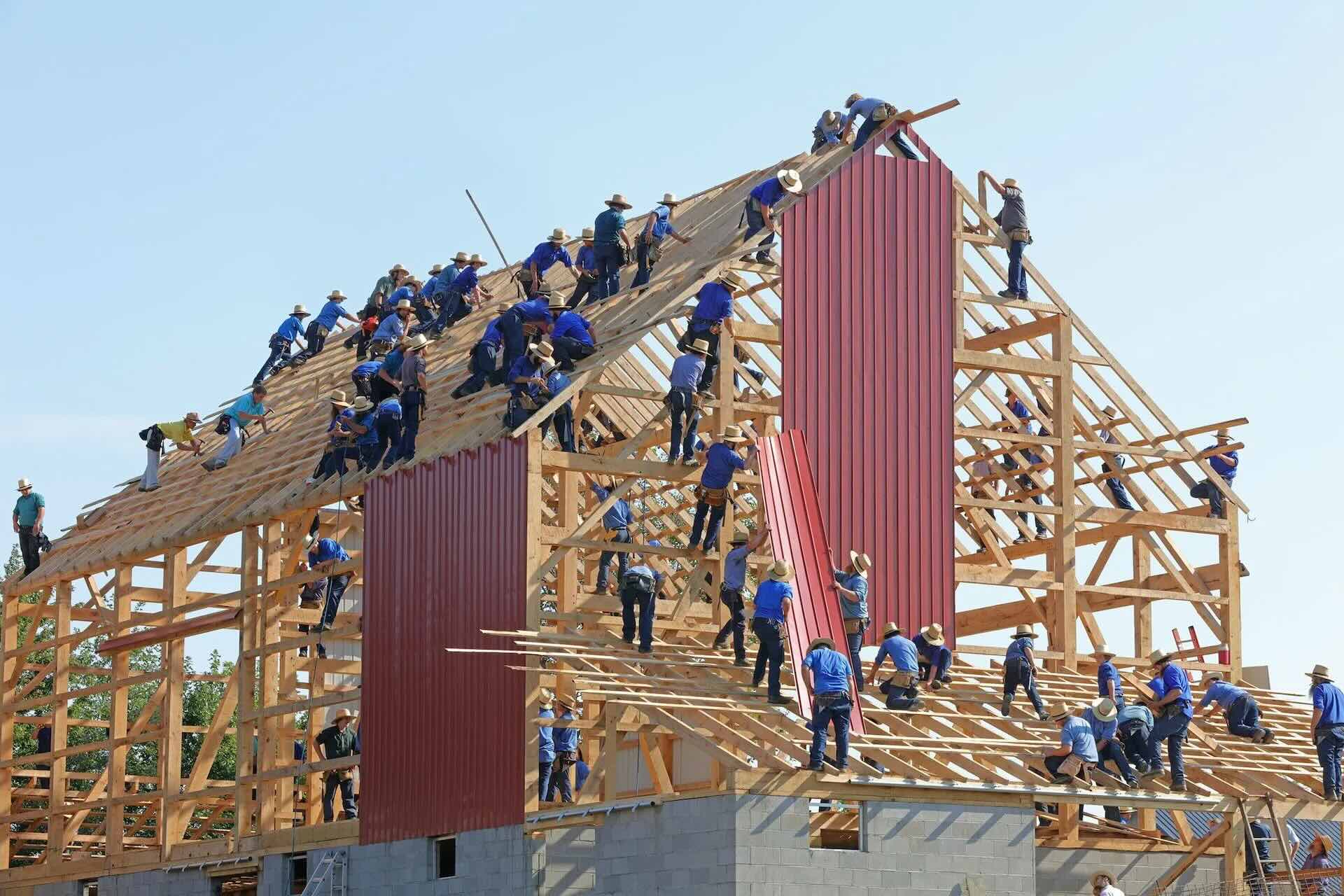Home>diy>Building & Construction>What Is The Tender Stage In Construction?


Building & Construction
What Is The Tender Stage In Construction?
Modified: December 7, 2023
Learn about the tender stage in building construction, including its importance and the process involved. Enhance your construction knowledge with our comprehensive guide.
(Many of the links in this article redirect to a specific reviewed product. Your purchase of these products through affiliate links helps to generate commission for Storables.com, at no extra cost. Learn more)
Introduction
The tender stage is a crucial part of the construction process that occurs before any work begins on a project. It involves the process of selecting a contractor or construction firm to carry out the construction work based on a set of criteria and specifications outlined by the client. This stage plays a significant role in ensuring the success of a construction project, as it is during the tender stage that the client evaluates and selects the most capable and suitable contractor for the job.
The tender stage can be considered as the bridge between the initial planning and the actual construction of a project. It is a time when the project moves from the theoretical stages of design and planning to the practical aspect of execution. At this stage, construction companies have the opportunity to bid for the project and showcase their expertise, experience, and capability to deliver the desired outcome.
During the tender process, clients have the chance to compare different contractors and their proposals to select the one that best meets their requirements in terms of quality, cost, and timeline. This ensures that the client gets the best value for their investment.
In this article, we will delve into the details of the tender stage in construction, including its definition, purpose, and the steps involved. We will also explore how tender documents are prepared and issued, the process of receiving and evaluating tenders, and the final step of awarding the contract.
Key Takeaways:
- The tender stage in construction is a pivotal process that allows clients to select the most capable contractor, obtain the best value for money, and minimize risks associated with the project.
- By following a systematic approach of preparing, issuing, receiving, evaluating tenders, and awarding the contract, clients ensure a fair and competitive environment for contractors to showcase their expertise and capabilities.
Read more: What Is Tender Document In Construction
Definition of the Tender Stage
The tender stage in construction refers to the phase in which the client invites interested contractors to submit their proposals or bids for the construction project. It is the formal process of selecting a contractor or construction firm to execute the project based on the client’s requirements, specifications, and criteria.
During the tender stage, the client provides all the necessary information about the project, including project plans, designs, technical specifications, and other relevant details. This allows the contractors to understand the scope of work and develop their proposals accordingly.
The tender stage can be seen as a competitive process, where multiple contractors compete to win the project. They are required to submit their bids, which outline their proposed cost, timeline, and approach to completing the project. The client then evaluates these bids to determine the most suitable contractor.
The tender stage typically occurs after the client has completed the initial planning and design phase of the project. It is an important milestone as it marks the transition from the conceptual phase to the practical phase of construction. It is during this stage that the client seeks to identify and select the contractor who can best meet their project goals and objectives.
It is worth noting that the tender stage is often governed by specific regulations and guidelines, depending on the country or region where the project is taking place. These regulations aim to ensure fairness, transparency, and equal opportunities for all contractors participating in the tender process.
The outcome of the tender stage is the selection of a contractor who will be awarded the construction contract. This selected contractor moves on to the next phase, which involves the formal signing of the contract and commencement of the construction work.
Overall, the tender stage is a crucial part of the construction process, allowing clients to evaluate and select the most suitable contractor to carry out their project. It provides an opportunity for contractors to showcase their expertise and compete for construction projects, ensuring that the chosen contractor is capable of delivering the desired results.
Purpose of the Tender Stage
The tender stage in construction serves several important purposes that contribute to the overall success of a construction project. Let’s explore the key purposes of the tender stage:
- Selection of the most capable contractor: The primary purpose of the tender stage is to allow the client to evaluate and select the most suitable contractor to carry out the construction work. By inviting bids from different contractors, the client can assess their capabilities, expertise, and track record to ensure that they have the necessary skills and experience to successfully complete the project.
- Comparison of proposals: The tender stage provides an opportunity for the client to compare and analyze the proposals submitted by different contractors. This enables the client to assess various aspects, such as cost, timeline, quality, and approach to the project. By comparing these proposals, the client can make an informed decision and select the contractor whose proposal aligns best with their project requirements.
- Ensuring transparency and fairness: The tender stage promotes transparency and fairness in the selection process. Contractors are expected to adhere to specific guidelines and regulations set by the client or relevant authorities. This ensures that all contractors have equal opportunities to bid for the project and that the selection is based on merit and compliance with the defined criteria.
- Obtaining the best value for money: The tender stage allows the client to evaluate and compare the costs proposed by different contractors. By considering both the price and the value offered by each contractor, the client can select the contractor offering the best value for their investment. This ensures that the project is executed within budget constraints without compromising on quality.
- Minimizing risks: The tender stage helps the client in assessing and mitigating risks associated with the construction project. Contractors are required to submit detailed information about their previous projects, financial stability, and risk management strategies. This information enables the client to evaluate the contractor’s ability to handle potential risks and challenges that may arise during the project.
Ultimately, the purpose of the tender stage is to select a contractor who not only meets the project requirements but also aligns with the client’s objectives and priorities. It allows the client to make an informed decision, ensuring that the chosen contractor is capable of delivering the desired results within the specified timeframe and budget.
Steps Involved in the Tender Stage
The tender stage in construction involves a series of steps that guide the process of selecting a contractor. These steps ensure that the client evaluates proposals thoroughly and selects the most suitable contractor for the project. Let’s explore the key steps involved in the tender stage:
- 1. Preparing the Tender Documents: The first step in the tender stage is to prepare the tender documents. These documents include project plans, technical specifications, contract terms, and any other relevant information necessary for the contractors to understand the scope of work. It is crucial to provide clear and detailed information to avoid misunderstandings or discrepancies during the bidding process.
- 2. Issuing the Tender Documents: Once the tender documents are prepared, the client issues them to potential contractors. This involves inviting interested contractors to participate in the tender process by submitting their proposals or bids. The tender documents should be distributed to contractors in a fair and transparent manner, ensuring that all interested parties receive the necessary information to prepare their bids.
- 3. Receiving and Evaluating Tenders: After issuing the tender documents, the client starts receiving tenders from the contractors. The client evaluates the tenders based on various criteria, including cost, timeline, quality, and compliance with project specifications. The evaluation process may include a review of the contractor’s qualifications, financial stability, and past project experience to assess their capability to execute the project effectively.
- 4. Clarifying and Negotiating: During the evaluation process, the client may need to seek clarifications or negotiate with the contractors regarding certain aspects of their proposals. This may involve discussions on pricing, project schedule, or any other specific requirements. The purpose of this step is to ensure that all parties have a clear understanding of the project and to address any concerns or issues that arise during the evaluation process.
- 5. Awarding the Contract: Once the evaluation and negotiation processes are complete, the client makes a final decision and awards the contract to the selected contractor. The contract award may be based on various factors, including the quality of the proposal, price competitiveness, track record, and compliance with project requirements. The client then informs the contractor of their successful bid and proceeds with contract formalities, such as signing the agreement and issuing any necessary documentation.
It is important to note that the tender stage is governed by specific timelines and deadlines, ensuring that the process is efficient and allows for fair competition among the contractors. The steps involved in the tender stage contribute to a thorough evaluation of the proposals and facilitate the selection of the most suitable contractor to carry out the construction project.
Preparing the Tender Documents
Preparing the tender documents is a crucial step in the tender stage of a construction project. These documents serve as a roadmap for interested contractors to understand the project’s requirements, scope of work, and the criteria by which their proposals will be evaluated. Here are the key aspects involved in preparing the tender documents:
- Project Specifications: The tender documents should include detailed specifications that outline the project’s technical requirements, materials to be used, and any specific industry standards or regulations that need to be followed. These specifications ensure that all contractors have a clear understanding of the project’s scope and can prepare their proposals accordingly.
- Project Plans and Drawings: The tender documents should include comprehensive project plans and drawings that depict the desired end result. This helps the contractors visualize the scope of work and enables them to accurately estimate the resources and materials required for the project. Clear and accurate plans and drawings minimize misunderstandings and inconsistencies during the bidding and execution phases.
- Contract Terms and Conditions: It is essential to include the terms and conditions that will govern the contractual relationship between the client and the contractor. This includes clauses related to payment terms, project timeline, performance guarantees, dispute resolution mechanisms, and any other relevant contractual obligations. Clear and well-defined terms and conditions protect the interests of both parties and promote a fair and transparent tender process.
- Bidding Requirements: The tender documents should specify the requirements that contractors need to fulfill to be eligible to submit their proposals. This may include criteria such as contractor qualifications, financial stability, prior experience in similar projects, and the submission format for the proposal. Clear bidding requirements help the client assess the capabilities of the contractors and ensure that only qualified parties participate in the tender process.
- Evaluation Criteria: It is important to outline the criteria and factors that will be considered during the evaluation of the tenders. This allows the contractors to align their proposals to the client’s evaluation priorities and ensures a consistent and transparent assessment process. Evaluation criteria may include aspects such as cost, quality, timeline, technical expertise, and compliance with project requirements.
When preparing the tender documents, it is crucial to provide clear and concise information, avoiding any ambiguities or contradictions that may lead to misinterpretation. Additionally, the tender documents should be reviewed by legal and technical experts to ensure that they comply with relevant regulations and industry standards.
By providing comprehensive and well-defined tender documents, the client ensures that all participating contractors have a clear understanding of the project requirements. This allows for fair competition and leads to more accurate and competitive proposals from the contractors, ultimately facilitating the selection of the most suitable contractor for the construction project.
During the tender stage in construction, it’s important to thoroughly review and compare the bids from different contractors to ensure you are getting the best value for your project. Look beyond just the cost and consider factors such as experience, qualifications, and references.
Read more: What Is A Tender Process In Construction?
Issuing the Tender Documents
Issuing the tender documents is a critical step in the tender stage of a construction project. It involves providing the necessary information and documentation to potential contractors, inviting them to submit their proposals or bids for the project. Here are the key aspects involved in issuing the tender documents:
- Identifying Potential Contractors: The first step in issuing the tender documents is identifying potential contractors who may be interested in participating in the tender process. This can be done through market research, industry contacts, or by inviting contractors who have previously expressed interest in similar projects. It is important to have a diverse pool of potential contractors to ensure fair competition.
- Preparing the Tender Package: The tender package includes all the necessary documents and information that contractors require to prepare their proposals. This includes project specifications, plans and drawings, contract terms and conditions, bidding requirements, and evaluation criteria. The tender package should be comprehensive and clearly organized to facilitate contractors’ understanding and preparation of their proposals.
- Distributing the Tender Package: The tender package should be distributed to potential contractors in a fair and transparent manner. This can be done through various means, such as electronic distribution via email or through a dedicated online portal, or physical distribution by mailing hard copies. The distribution process should ensure that all interested contractors receive the tender package within a specified timeframe.
- Providing a Tender Briefing: It is beneficial to conduct a tender briefing or site visit to provide additional information about the project and address any queries that potential contractors may have. This allows the contractors to gain a deeper understanding of the project and clarifies any potential ambiguities in the tender documents. A tender briefing also provides an opportunity for contractors to interact with the client and establish a more collaborative relationship.
- Setting a Tender Submission Deadline: The tender documents should clearly indicate the deadline for submitting the proposals. This allows the contractors sufficient time to prepare their bids while ensuring that the client receives all the proposals within a specific timeframe. The tender submission deadline should be reasonable and provide enough time for contractors to gather the required information and present their proposals accurately and comprehensively.
When issuing the tender documents, it is important to maintain open communication with the potential contractors. This involves promptly addressing any queries or clarifications they may have and providing equal opportunities for all bidders. It is also crucial to adhere to any legal and regulatory requirements regarding the tender process.
By issuing the tender documents effectively, the client ensures that all interested contractors have access to the necessary information to prepare their proposals. This promotes a fair and competitive tender process and allows the client to receive a diverse range of proposals, enabling them to select the most suitable contractor for the construction project.
Receiving and Evaluating Tenders
The receiving and evaluating of tenders is a crucial step in the tender stage of a construction project. It involves the comprehensive assessment of the proposals or bids submitted by the contractors. Here are the key aspects involved in receiving and evaluating tenders:
- Receipt of Tenders: Upon the tender submission deadline, the client receives the submitted tenders from the participating contractors. It is important to ensure that all tenders are received within the specified timeframe to maintain fairness and transparency in the evaluation process.
- Tender Opening: The client, along with a designated evaluation team, opens and records the details of each submitted tender. This is typically done in the presence of the participating contractors or their representatives to establish transparency and ensure that all submitted tenders are accounted for.
- Tender Compliance Check: The client reviews each tender to ensure that it meets all the specified requirements and adheres to the stated guidelines. This includes verification of required documentation, such as financial statements, technical qualifications, and compliance with the stated criteria. Tenders that do not meet the necessary requirements may be disqualified from further evaluation.
- Evaluation Criteria: The client establishes a set of evaluation criteria based on the project’s requirements and priorities. These criteria may include factors such as cost, quality, technical expertise, past experience, and compliance with project specifications. Each criterion is assigned a weightage to reflect its importance in the overall evaluation process.
- Evaluation Process: The client and the evaluation team rigorously assess each tender based on the established criteria. This involves reviewing the proposed cost, construction schedule, methodology, quality control measures, and other relevant aspects specified in the tender documents. The evaluation may also include site visits or interviews with the bidding contractors to gain a deeper understanding of their proposals.
- Comparison and Scoring: The client and the evaluation team compare and score each tender based on the established evaluation criteria. This allows for a consistent and objective assessment of the proposals. The scoring may be done individually by each evaluator, followed by a collective discussion and consensus building to determine the final scores.
- Shortlisting of Contractors: Based on the evaluation scores, the client shortlists a smaller pool of contractors who have submitted the most competitive and suitable tenders. These shortlisted contractors are usually invited for further discussions or negotiations to clarify any outstanding matters, refine their proposals, and finalize the contract terms.
- Contractor Selection: After the shortlisting and negotiation process, the client makes the final decision on the contractor who will be awarded the construction contract. The selection is based on various factors, including the contractor’s technical competency, proposed cost, project timeline, and overall alignment with the project’s goals and requirements.
During the tender evaluation process, it is essential to maintain confidentiality and avoid any bias or unfair influence. The evaluation should be carried out objectively and based on the established criteria to ensure a fair and transparent selection process.
By carefully receiving and evaluating tenders, the client can select the most suitable contractor who best meets the project’s requirements. This helps to ensure a successful and efficient execution of the construction project.
Awarding the Contract
The awarding of the contract is the final step in the tender stage of a construction project. It involves the selection of the contractor who will be entrusted with executing the project based on their submitted tender and successful evaluation. Here are the key aspects involved in awarding the contract:
- Contractor Notification: Once the evaluation process is complete and the selected contractor has been determined, the client notifies the contractor of their successful bid. The notification should be conducted promptly and in a formal manner, often through a formal letter or email, stating that the contractor’s tender has been accepted for the project.
- Contract Negotiation: After notifying the selected contractor, the client enters into the contract negotiation phase. This involves discussing and finalizing the terms and conditions of the contract, including the scope of work, project timeline, payment terms, and any other relevant provisions. Both parties may negotiate and make necessary adjustments to ensure that the finalized contract meets the project’s objectives and addresses the interests of both the client and the contractor.
- Signing the Contract: Once the contract negotiations are complete, the client and the selected contractor officially sign the contract. This signifies the formal agreement between both parties and legally binds them to the terms and conditions outlined in the contract. The signing of the contract is a significant milestone, as it marks the transition from the tender stage to the execution stage of the construction project.
- Contract Award Announcement: It is common practice for the client to make a public announcement regarding the awarded contract. This announcement may be made internally to project stakeholders or externally through a press release. The purpose is to inform interested parties, such as other contractors or the general public, about the chosen contractor and the upcoming construction project.
- Contract Documentation: After the contract is signed, the client prepares all necessary documentation related to the contract. This includes creating a contract file that contains all relevant information, such as the signed agreement, project specifications, plans, and any other supporting documentation. Proper documentation ensures that all parties involved have access to the necessary information throughout the construction phase.
It is essential during the contract award process to maintain transparency, fairness, and professionalism. All parties should adhere to any legal and regulatory requirements governing the contract award process, ensuring that the award is based on a thorough evaluation and merit-based decision-making.
By awarding the contract to the selected contractor, the client solidifies the partnership and sets the stage for the successful execution of the construction project. The awarded contractor can now proceed with mobilizing resources, finalizing project plans, and commencing construction activities.
Conclusion
The tender stage is a vital component of the construction process, playing a crucial role in selecting the most suitable contractor to carry out a construction project. Throughout the tender stage, the client evaluates the proposals or bids submitted by contractors, considering various factors such as cost, quality, timeline, and compliance with project requirements. By following a systematic approach, the client can make an informed decision and award the contract to the contractor who best meets their needs.
The tender stage encompasses several key steps, including preparing the tender documents, issuing them to potential contractors, receiving and evaluating tenders, and ultimately awarding the contract. Preparing comprehensive and clear tender documents sets the foundation for a successful tender process, ensuring that contractors have a clear understanding of the project requirements. Issuing the tender documents fairly and transparently allows for equal opportunities for contractors to participate in the tender process.
During the evaluation stage, the client carefully assesses each tender based on established criteria, and shortlists contractors who have submitted the most competitive and suitable proposals. After negotiations and finalizing the contract terms, the client awards the contract to the selected contractor. This marks the transition from the tender stage to the execution stage of the construction project.
The tender stage serves multiple purposes, including selecting the most capable contractor, obtaining the best value for money, and minimizing risks associated with the construction project. It ensures transparency, fairness, and a competitive environment for contractors to showcase their expertise and capabilities.
In conclusion, the tender stage is a critical phase in the construction process, allowing clients to choose the most suitable contractor and setting the project on the path to success. By carefully preparing and issuing the tender documents, receiving and evaluating tenders, and awarding the contract, clients can ensure that their construction projects are executed by qualified professionals who can deliver the desired outcomes.
Frequently Asked Questions about What Is The Tender Stage In Construction?
Was this page helpful?
At Storables.com, we guarantee accurate and reliable information. Our content, validated by Expert Board Contributors, is crafted following stringent Editorial Policies. We're committed to providing you with well-researched, expert-backed insights for all your informational needs.















0 thoughts on “What Is The Tender Stage In Construction?”